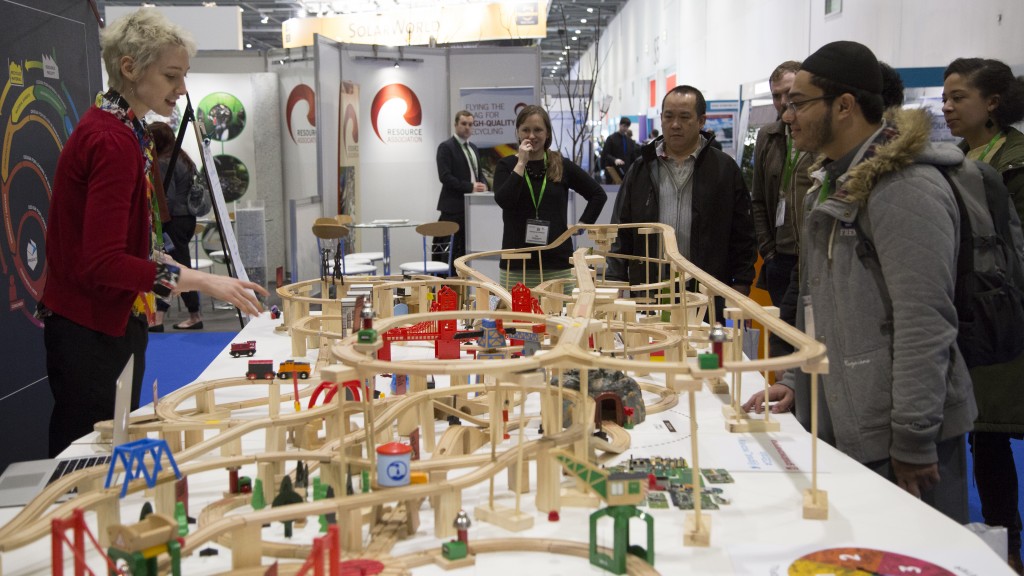Resources - Past event
Resource 2015 and the Game of Circularity

Josie Warden reflects on our recent stand at Resource 2015
When I tell people that I am trying to promote the circular economy, I am often met with a blank stare. But when I explain the drivers for moving away from our current model (we have a finite amount of resources, increasing demand for those resources and an environment which is burdened by our current ‘take, make, throw away’ thinking), then they are pretty well understood. Everyone has experienced the frustration of having to chuck away a kettle because of a broken lid, or the guilt of throwing plastic into a waste bin. At the basic level, people get it: it is common sense to design products and systems so that they can be reused, recycled, leased or repaired and remanufactured.
But if the need to change from a linear view to a cyclical one is not hard to grasp, ask people to explain what this means in practice and we’re back to the blank faces. Hiding beneath the surface of this simple and beautiful concept is a tangle of mind-blowingly complexity.
So, to change our route, we need people to be engaged and empowered enough to really start to unpick, tackle and implement the changes needed. We need to prototype new types of products, but above all we need to communicate a systemic picture of the circular economy.
Engaging the Engine of Design
At the recent Resource show 2015, we created a stand reflecting circularity in action: from design, through manufacturing, to waste, with loops for redesign and repair.
Centre stage rolled the Circular Economy Train…nostalgic, engaging and fun; this enormous Brio set certainly drew the crowds. Players were tasked with manufacturing a household product by making real design decisions, about material type, business model and supply chain, at a series of ‘design junctions’ as their engine traversed the route. From first year students through to the entire sustainability team from Marks & Spencer, there was stiff competition to design the best way through the game, and prevent the little engines toppling straight into the landfill (a bucket at the end of the table!)
But it wasn’t simple. In making a product you are connected, by default, with much wider systems than may be represented by your own business plan. And so, in our game, you could make great choices of your own but still be knocked out of line by external forces: global competition for land and resources, fickle trends, costs of transportation. All these are challenges facing the designers of a new circular economy and were represented by our ‘tunnel of conflict’, ‘resource randomiser’ (spin to determine your fate) and a pack of action cards – just like Chance in Monopoly. The genius of the game was that it enabled us to show, at a glance, not only the complexity of circularity but also the deterministic nature of design in deciding the fate of products.

The rest of the stand was zoned to take you through the stages of a circular economy: Design, Making and Use or Waste.
We showcased designers whose work is already nudging us towards circular thinking: Rob Maslin from We All Design who is developing service design for a circular economy; Rich Gilbert from the Agency of Design who is working with clients on products for return and circularity; and the Restart Project who, as skilled repairers, are enabling us to extend the lifetimes of our everyday electronics.
In the manufacturing zone we hosted a pop-up makespace with our partners at Fab Lab London, complete with 3D printers and laser cutters, and demonstrating the potential for new technologies to help innovate and prototype new design practices. Fab Lab were also on hand to help us put repair into action, printing a replacement handle for a toaster and thus helping to extend its life. Along with Restart this represented the opportunity for not only experts but also citizens and communities to get involved in design.

The use and waste phase of the economy was represented by our recent Bulky Waste Design Residency with SITA, and highlighted the challenges and the potential in dealing with large household items and furniture at end of life. Our Kitchen Table hosted pop-up workshops with the design residents themselves, and also saw serendipitous meetings between mattress entrepreneurs, behaviour change students and business leaders.
Over the three days we played games, we shared stories, and we found fascinating and enlightening insights.
And the final destination for circular economy? Not the end of the track but, according to our game, circular enlightenment and product heaven! Most importantly, an alignment of economic, social and environmental objectives. And who wouldn’t want to get there?
With special thanks for PwC for sponsoring the prizes for the Circular Train game. Two delighted top scorers of the game each won a beautiful Elvis & Kresse bag, made from decomissioned fire hoses.





